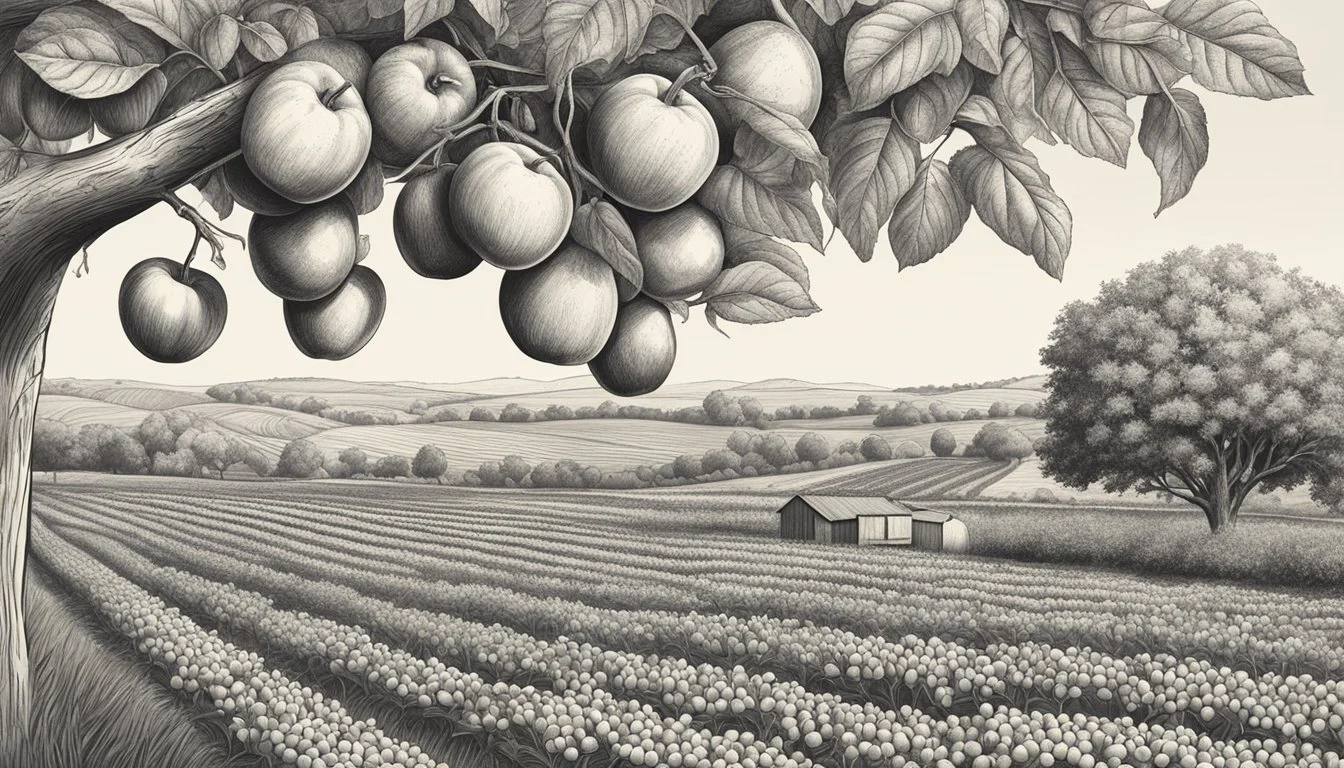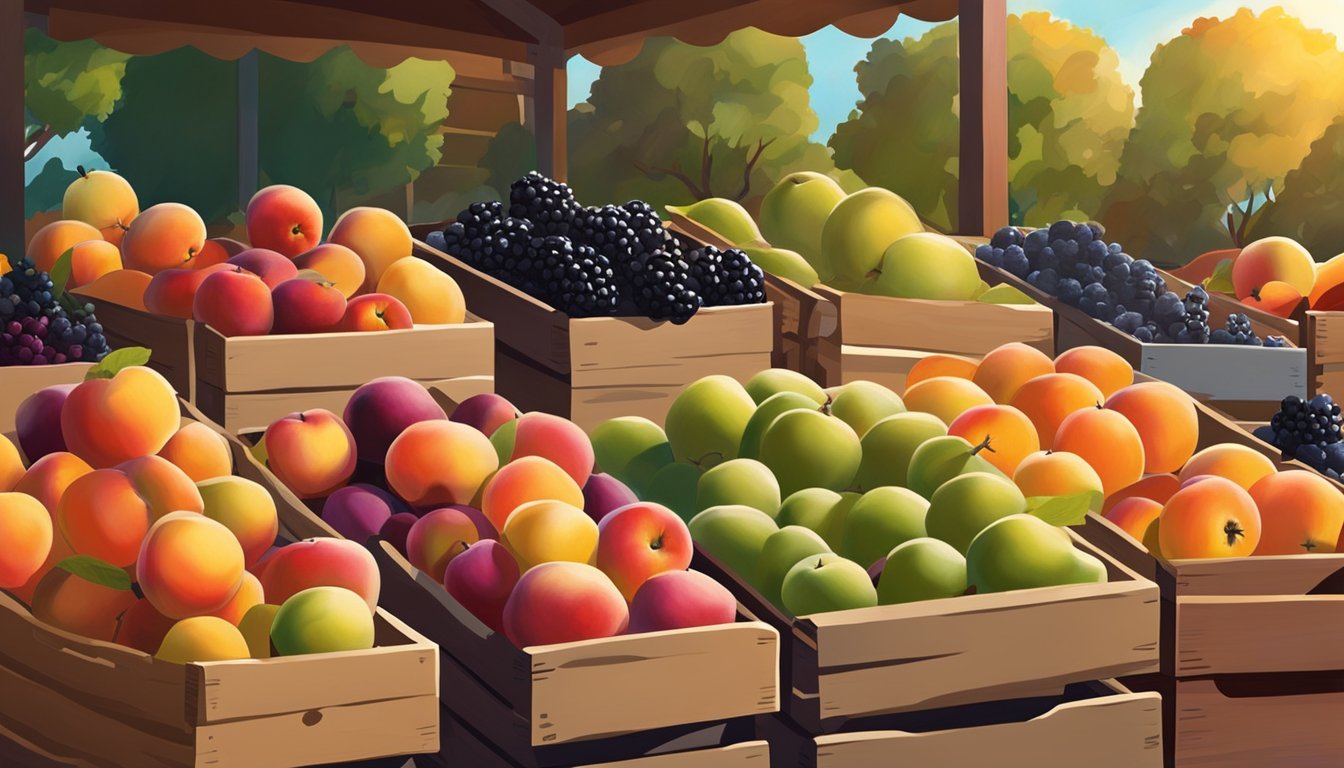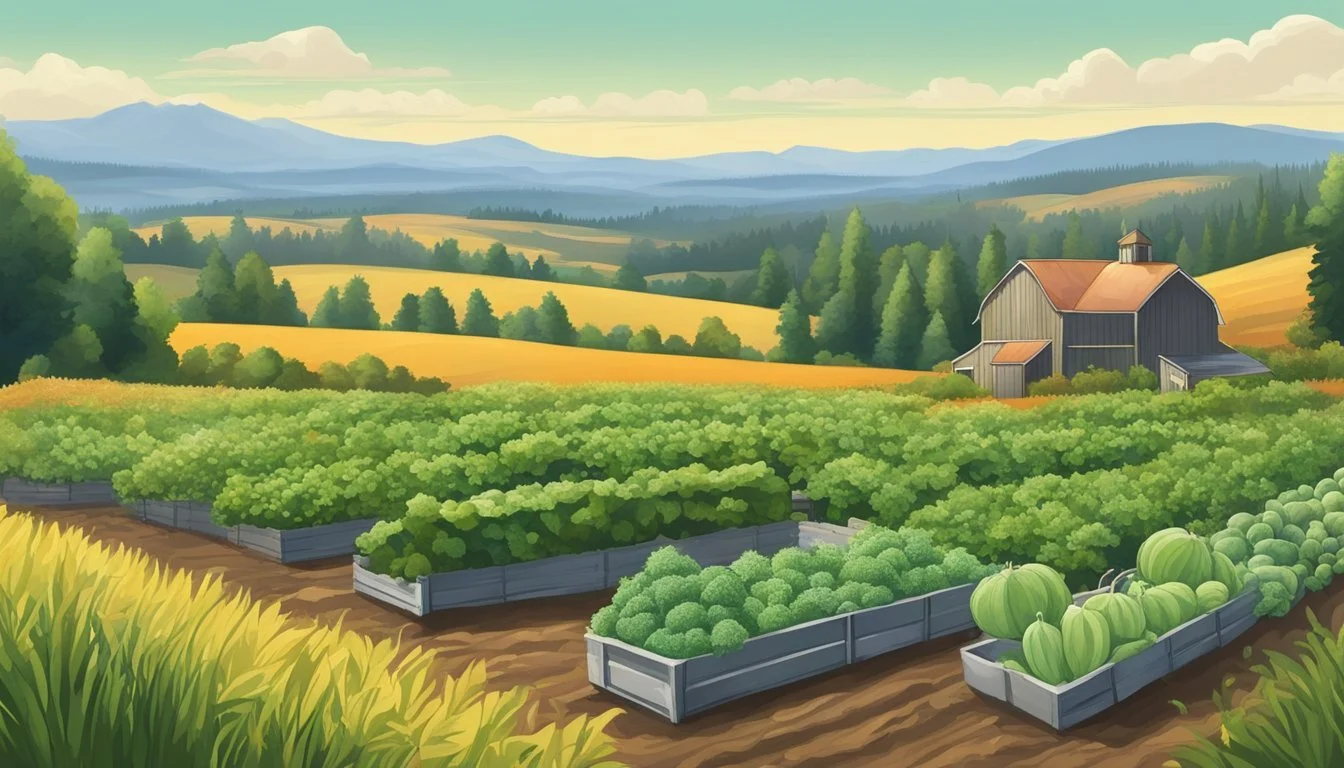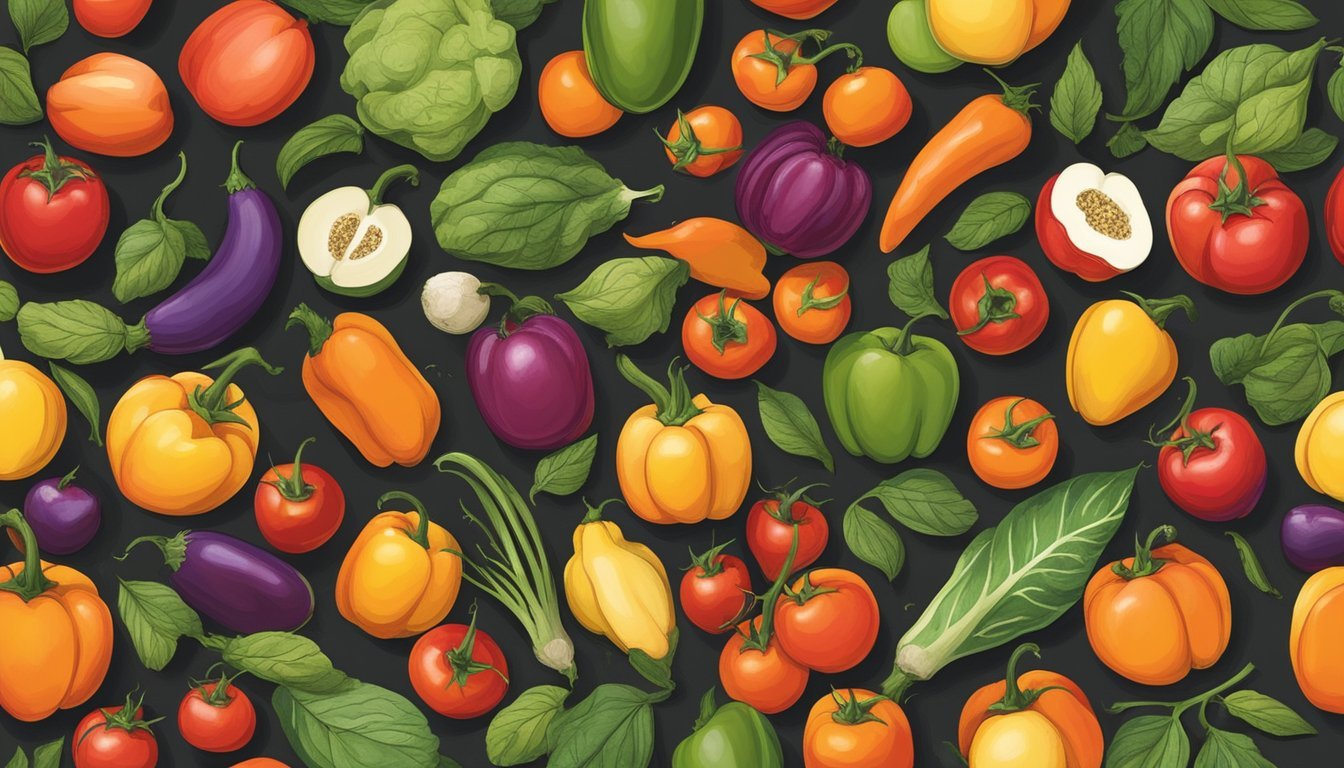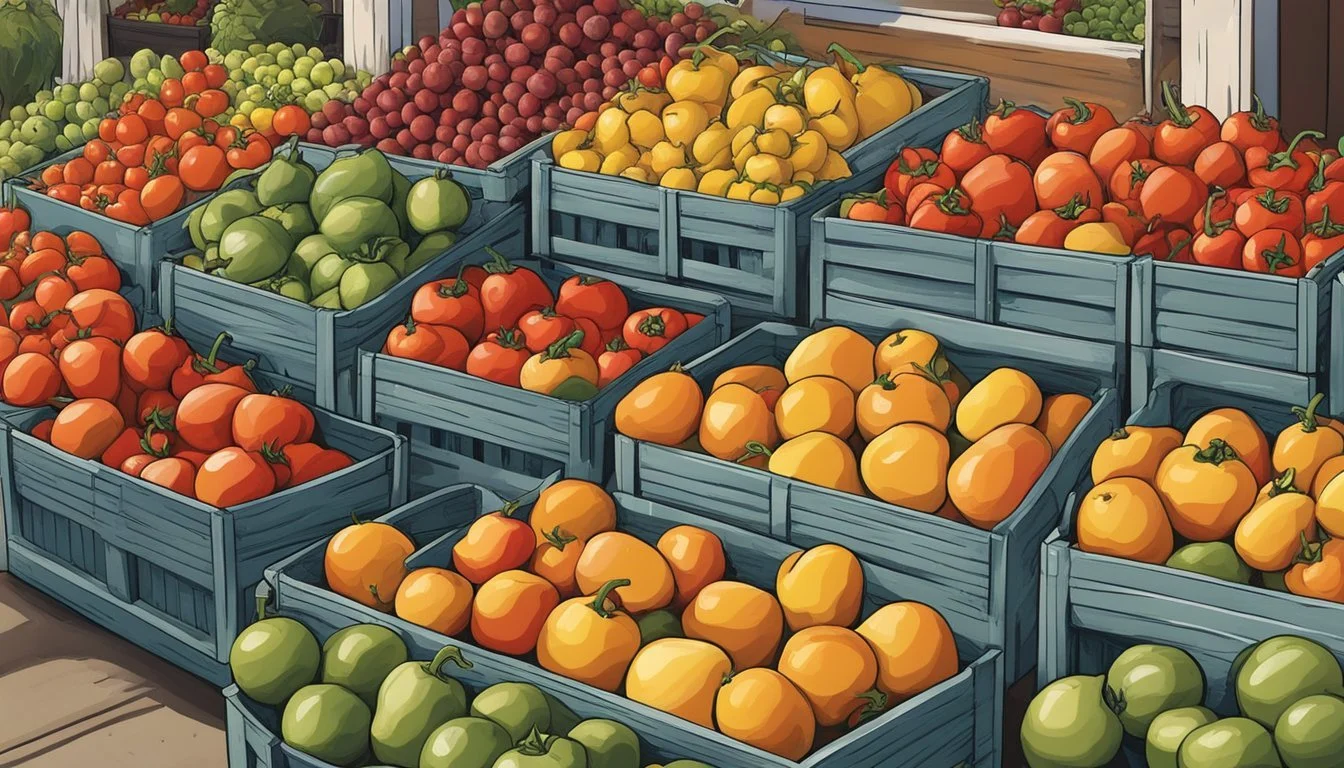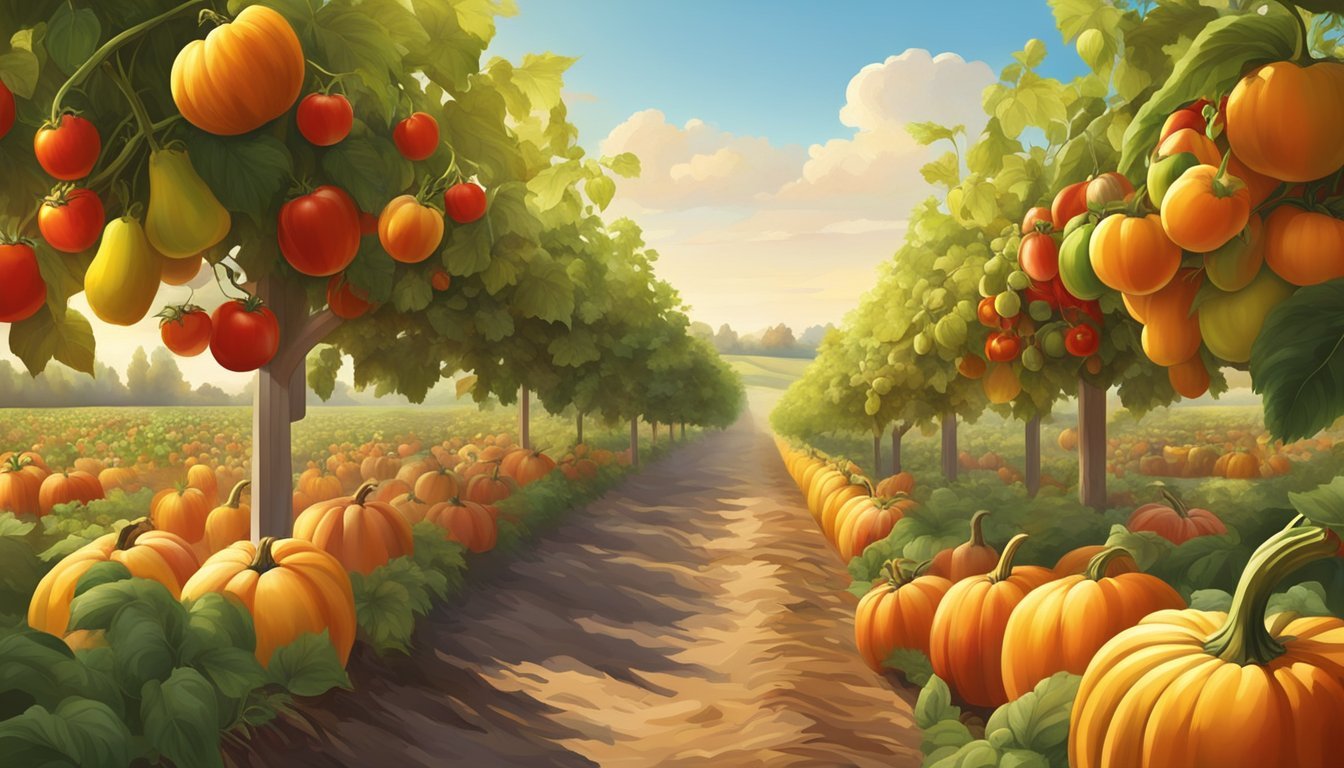Oregon Seasonal Fruit & Vegetables in September
A Guide to Fresh Produce
This Article is Part of our Oregon Seasonal Fruit & Veg Calendar
September in Oregon brings with it a harvest of vibrant produce, marking a shift in seasons where summer's abundance meets the early whispers of fall. This transitional month is particularly rich for fruit (What wine goes well with fruits?) and vegetable lovers, as it offers a mixed bag of both late-summer and early-autumn crops. In the realm of fruits, Oregon's fertile lands yield a bounty of berries, with blueberries and raspberries approaching the end of their season, while pears and apples (how long do apples last?) begin to take center stage, promising the crisp flavors synonymous with autumn.
The vegetable patches are no less impressive. Leafy greens like arugula and spinach thrive in the cooler weather, while root vegetables including carrots, beets, and radishes grow robustly. The state celebrates a wealth of cruciferous vegetables as well, such as broccoli (how long does broccoli last?), Brussels sprouts, and cauliflower, which are not only in season but are also reaching their peak flavor and nutritional value.
Throughout Oregon, September is a testament to the state's rich agricultural diversity. From orchards heavy with fruit to fields abundant in verdant produce, the local fare is a testament to the bounteous yields that Oregonian farmers bring to the table. Market-goers and food enthusiasts have the chance to indulge in the freshest, locally-sourced fruits and vegetables, each celebrating the unique flavors and culinary possibilities of the season.
Overview of Oregon's Seasonal Produce
September in Oregon is a vibrant time for harvest, where an array of produce reaches its peak. The transition into fall brings forth a bounty of fruits and vegetables, each with distinct seasonal varieties. They have nurtured a deep connection with the soil and climate of the region, resulting in produce of outstanding quality and flavor.
Fruits ripe for picking in September include:
Apples: A signature fall fruit with numerous varieties such as Gala and McIntosh.
Pears: Bartlett pears, among others, are succulent and ready.
Plums: Juicy and sweet, perfect for preserves or fresh eating.
Vegetables also feature prominently in Oregon's September harvest:
Corn: Sweet and tender, a staple of late summer bounty.
Tomatoes: Ripe and full-flavored, with heirloom varieties highly sought after.
Squash: Acorn and butternut squash hint at the coming fall comforts.
Farmers' markets are abundant with these seasonal varieties, showcasing the best of what local agriculture has to offer. Consumers not only find fresh and nutritious options but also get to support the local economy and sustainable practices.
In terms of greens, varieties such as:
Kale
Spinach
Chard
remain in season, offering a continuation of summer's leafy options for healthy meals.
Oregon's agricultural landscape prides itself on a natural cycle of growth and renewal. As such, September's harvest reflects the state's dedication to fostering a connection between land and table, where seasonal produce is celebrated for its diversity and regional adaptation.
Seasonal Fruits in September
September in Oregon is a time of abundance for fruit lovers, as a variety of tree fruits, berries, melons, and stone fruits reach their peak ripeness.
Tree Fruits
Oregon's September harvest brings a delightful variety of tree fruits. Apples and pears are the front runners, with many varieties available for consumption in their freshest form. Apples serve as a versatile fruit, perfect for eating raw or incorporating into recipes. Pears, ranging from buttery to crisp, provide another sweet treat for those who enjoy them fresh.
Apples: Multiple varieties
Pears: Various types
Berries
While the berry season begins to wind down, there is still joy to be found in Oregon's berry patches. Raspberries and blackberries (how long do blackberries last?) continue to offer their sweet and slightly tart flavors to the seasonal palate, enjoyed raw or in desserts.
Raspberries: Late season picks
Blackberries: Final harvests
Melons and Stone Fruits
The melon and stone fruit offerings remain rich with flavor during this month. Sweet, aromatic melons are available, providing a juicy and refreshing option on warmer September days. The stone fruit category sees the last of its peaches, nectarines, and plums, each bringing their signature juicy sweetness to the table.
Melons: Juicy varieties
Peaches: Sweet end of season fruits
Nectarines: Similar to peaches in sweetness
Plums: Sweet and slightly tangy
Late Summer Harvest
As summer transitions into fall, other fruits such as grapes and figs become ready for harvest. Oregon's climate lends itself to producing sweet and flavorful grapes perfect for raw eating or wine making. Figs, with their unique taste and texture, also make a late summer appearance, adding diversity to the seasonal selection.
Grapes: Ready for harvest
Figs: Late summer delight
Seasonal Vegetables in September
As September arrives in Oregon, it marks a bountiful period for a variety of vegetables. Gardens and farms are particularly rich with root vegetables, winter squashes, a plethora of leafy greens, and a selection of vegetables that straddle the line between the waning summer and the approaching autumn.
Root Vegetables
Oregon's soil yields several nutritious root vegetables during September. Gardeners and chefs alike eagerly await the harvest of:
Carrots: Crisp and sweet, ideal for both raw and cooked dishes.
Beets: Their earthy flavor enriches salads and side dishes.
Potatoes: A staple in cooking, with diverse varieties ready for harvest.
Onions: Essential for flavoring a vast range of culinary creations.
Squashes and Gourds
The state's agriculture proudly showcases various squashes, each with its unique culinary use:
Squash: Includes varieties like acorn and butternut, suitable for baking and soups.
Pumpkins: Beyond decoration, they're excellent for pies and roasting.
Zucchini: Harvested when young for the best flavor and texture.
Leafy Greens and Brassicas
Nutrient-rich greens are in their prime, offering both flavor and vitality:
Cabbage: A versatile vegetable that can be used in salads, stews, and fermentations.
Kale: Robust and hearty, perfect for salads and chips.
Spinach: Tender and ideal for salads, sautés, and as a cooked green.
Broccoli: Known for its use in a multitude of dishes, from salads to stir-fries.
Summer to Fall Transition Vegetables
Some vegetables bridge the seasonal gap, thriving as the climate cools:
Cucumbers: Still available early in the month, crisp and refreshing.
Green Beans: Tender and flavorful, picked at the peak of freshness.
Peppers: Range from sweet to hot, adding a kick to dishes.
Tomatoes: The last of the season are perfect for canning or sauces.
Herbs and Other Edibles in September
September in Oregon marks a time of rich flavor and aromatic produce. Home cooks and chefs alike celebrate the fresh herbs and unique edible plants that can elevate any dish with their vibrant flavors and scents.
Herbs
During this month, the herb garden is particularly generous. Basil, an aromatic staple, thrives until the first frost, offering its fresh, peppery sweetness to various recipes. Adjacent in the garden, Rosemary and Sage provide bold, piney and earthy notes respectively. These herbs not only enhance the flavor profile of dishes but also fill the kitchen with inviting aromas.
Herb options commonly available:
Basil
Rosemary
Sage
Alliums and Uniques
The allium family boasts its presence in September with Garlic and Leeks. Garlic, with its unmistakable heat and intensity, is sought after for both its culinary and health properties. Leeks, offering a milder, sweet onion-like flavor, are excellent in soups and stews. Alongside these, edible flowers start to make their last bright stand, adding not just decoration but also subtle floral essences to salads and desserts.
Noteworthy alliums and unique edibles include:
Garlic
Leeks
Edible Flowers (limited varieties)
Incorporating these herbs and edibles into meals brings not only depth of flavor but also a touch of the Oregon fall essence to your table.
Oregon's Agricultural Regions and Climates
Oregon's diverse climate zones significantly influence the varieties of fruits and vegetables that can be cultivated across the state. These regional climates range from the warm, dry interior to the cool, wet coast, each supporting different agricultural products.
Valley Regions
The Willamette Valley, nestled within the surrounding mountain ranges, is Oregon's agricultural heartland. It has a temperate climate that is ideal for a wide range of crops. The valley's warm summers and wet winters are conducive to:
Apples
Pears
Hazelnuts
Various berries
Root vegetables
This region benefits from a long growing season. The Central Oregon area, while part of the valley regions, presents a cooler climate with great temperature fluctuations, which can be challenging for some crops but provides ideal conditions for others that require cooler nights.
Coastal and Mountain Areas
Coastal Oregon is known for its moist, cool climate that yields a different set of agricultural products in comparison to the valley regions. Its climate is characterized by:
Mild temperatures
High precipitation
Reduced temperature variability
These conditions are especially suitable for cultivating:
Coastal berries
Leafy greens
Some root crops
The mountain areas provide a shorter growing season due to cooler temperatures but still support a variety of hardy fruits and vegetables. Each of these regions contributes uniquely to the state's rich agricultural tapestry.
Harvesting and Storing Tips
Harvest season in Oregon brings a bounty of fresh produce that can last well into winter if harvested and stored correctly. Focusing on proper techniques ensures maximum freshness and longevity of the produce.
Proper Harvesting Techniques
When harvesting, one should ensure that:
Apples are picked when they come away easily from the branch with a simple twist.
Winter Squash is harvested when the rind is hard and the stem starts to crack.
For most vegetables and fruits, they should feel firm to the touch and be free of bruises and blemishes, which are indicators of quality and freshness. The time of day also matters; it is best to harvest in the cool early morning to help maintain the quality of the produce.
Storage Practices
To extend the shelf life and maintain the quality of the harvest:
Apples: Store in a cool, dark place between 32°F and 40°F. Apples can be kept in perforated plastic bags to retain moisture but should be checked regularly for signs of spoilage.
Winter Squash: Cure for 10 days in a warm and dry place, then store at room temperature around 50°F to 60°F in a dry area.
Hermetic sealing or using airtight containers can protect against moisture and pests. For most September harvest produce, adequate ventilation is crucial to prevent the accumulation of ethylene gas and moisture, which can lead to spoilage.
Culinary Suggestions and Uses
September in Oregon brings a bounty of fruits and vegetables that can transform any meal with their freshness and flavor. This month, the focus is on creating dishes that showcase the best of the season's produce, with an emphasis on balancing sweet and tart fruit flavors, crafting hearty vegetable dishes, and curating vibrant salads and side options.
Sweet and Tart Fruit Recipes
Oregon's September harvest offers a variety of fruits that are perfect for sweet and tart recipes. Pears, plums, and apples are particularly versatile and can be used in dishes ranging from baked desserts to savory chutneys. Consider creating a Rustic Pear Tart that allows the natural sweetness of ripe pears to shine, or a Plum Compote as a tangy accompaniment for pork dishes.
Baked Apple Slices: A simple dessert that can pair well with cinnamon and a touch of honey.
Plum Sauce: Ideal for glazing meats or enhancing stir-fries with its sweet-tart dynamic.
Hearty Vegetable Dishes
Hearty dishes are quintessential for the cool evenings of September. Potatoes, carrots, and squash are foundational vegetables that lend themselves to rich, comforting recipes. A creamy Carrot and Squash Soup makes for a warming meal, while roasted potatoes can be a robust side dish to any protein.
Stuffed Squash: Fill acorn squash with a blend of quinoa, nuts, and dried fruits for a nutritious main course.
Potato Gratin: Layers of thinly sliced potatoes with cheese and herbs baked until golden brown.
Salad and Side Options
Greens, cucumbers, and tomatoes are still plentiful in September and perfect for salads or fresh sides. Incorporating these into meals adds a necessary brightness that complements any dish. A simple Cucumber and Tomato Salad dressed with olive oil and vinegar can be a refreshing side, or combine a variety of greens for a Mixed Autumnal Salad that captures the essence of the season.
Sautéed Greens: Quickly sauté greens like spinach or kale with garlic for a healthy side.
Roasted Vegetables: Combine several vegetables like carrots, potatoes, and squash, season, and roast for a colorful and flavorful side.
By focusing on seasonal produce, every recipe created during September in Oregon can celebrate the natural peak of flavor that these ingredients offer. Whether these fruits and vegetables are incorporated into main dishes, desserts, or sides, they have the power to elevate the dining experience with their fresh, robust flavors.
Supporting Local Oregon Farms
In September, Oregon's bountiful harvest provides an excellent opportunity for consumers to support local agriculture. By engaging with farmers' markets and community-supported agriculture programs, individuals contribute to the state's sustainable and organic food systems.
Farmers' Markets and CSAs
In the state of Oregon, farmers' markets serve as a pivotal point of contact between local farmers and consumers. These markets are especially vibrant in September, showcasing a variety of fresh produce that includes apples, pears, tomatoes, and an array of leafy greens. Consumers can directly support local farmers by purchasing their products, thus ensuring that their money is reinvested into the local economy.
Additionally, Community Supported Agriculture (CSA) programs offer a way for consumers to buy seasonal produce directly from the farmers. By participating in a CSA, individuals receive regular deliveries or pick-ups of fresh produce throughout the farming season. This model provides farmers with upfront, reliable funding and gives consumers access to the freshest, often organic produce.
Farmers' Markets Benefits:
Encourages direct support of local farmers
Promotes seasonal eating and fresh produce
Connects community members with their food sources
CSAs Advantages:
Offers consumers the freshest seasonal produce
Provides farmers with consistent support
Fosters a direct relationship between farmers and the community
Sustainability and Organic Practices
Oregon farmers are recognized for their commitment to sustainable and organic farming practices. These practices not only support the health of the environment but also produce high-quality foods without the use of synthetic pesticides or fertilizers. When consumers choose to purchase organic produce from local farms, they contribute to the demand for sustainable agriculture within the state.
The prevalence of organic farming in Oregon is indicative of the state's dedication to environmental stewardship and health-conscious agriculture. As individuals support these farms, they help maintain the biodiversity of the region and reduce the carbon footprint associated with long-distance food transport.
Sustainable Practices:
Reduced chemical usage protects ecosystems
Local sourcing minimizes transportation emissions
Conservation of soil and water resources
Organic Benefits:
High-quality foods free from synthetic additives
Support for non-GMO crop production
Encouragement of humane treatment of animals on organic farms
Nutritional Benefits of Seasonal Eating
Eating fruits and vegetables in their respective seasons can enhance the nutritional intake of one's diet. Seasonal produce tends to be fresher and, therefore, contains higher levels of nutrients than out-of-season counterparts that may have traveled long distances and been stored for long periods.
Fruits and vegetables harvested during their peak months generally possess more vitamins and antioxidants. For example, broccoli and kale, ripe in September in Oregon, are rich in vitamins A, C, and K, as well as fiber, which supports digestive health. These nutrients are more potent when consumed soon after harvest.
The practice of eating seasonally encourages a diverse diet that cycles throughout the year. This variety ensures a broader spectrum of nutrients, reducing the risk of nutrient deficiencies. Individuals consuming a diversity of produce are more likely to intake an array of minerals and phytochemicals that support overall health.
Fresh, seasonal foods may also provide better flavor and quality. This improvement in taste may encourage higher consumption of healthy, raw fruits and vegetables, thereby increasing nutrient intake without the need for added sugars or preservatives.
Below is a list of some nutrient-dense vegetables and fruits available in September in Oregon, which contribute to a healthful diet:
Blackberries & Blueberries: High in antioxidants and vitamin C
Pumpkins: Rich in vitamin A and fiber
Cauliflower & Broccoli: Good sources of vitamins C and K
Leafy Greens (e.g., Spinach, Kale): Abundant in iron, calcium, and several essential vitamins
Consuming these seasonal foods supports not only nutritional health but also the local farming community and the environment by reducing the necessity for transportation and storage.
Challenges and Considerations for September Harvest
September marks a transitional period for Oregon's agriculture, where the shift from warm summer to cooler fall imposes specific challenges for harvesting fruits and vegetables.
Weather Impacts
September’s weather in Oregon can be unpredictable, with an array of warm days followed by a sudden cool down as fall approaches. Fruit crops such as tomatoes may require protection against the cooler nights. Farmers often implement strategies to shield these crops from early frosts, including using row covers or bringing green fruit indoors to ripen.
For vegetables, maintaining soil warmth is crucial as cold soil can slow down the growth of crops like bell peppers and squash. Sudden temperature shifts can also affect the quality and yield of the produce. Sustainable farming practices, like the usage of greenhouses or cold frames, can help mitigate the risk of weather-related crop damage.
Pest and Disease Management
Pests and diseases pose a significant threat to the September harvest, especially as the climate transitions from warm summer months into fall. Fruit crops may encounter increased instances of late-season insect pests such as aphids and spider mites, which can impact the quality of the harvest. It is critical to monitor and manage these pests through integrated pest management techniques.
Vegetable crops can face diseases like powdery mildew or blight, exacerbated by the September humidity and cooler night temperatures. Farmers must be vigilant in their disease management practices, employing crop rotation, appropriate spacing for air circulation, and if necessary, the use of organic or conventional fungicides. The overall aim is to ensure a healthy, robust harvest while maintaining environmental integrity.

